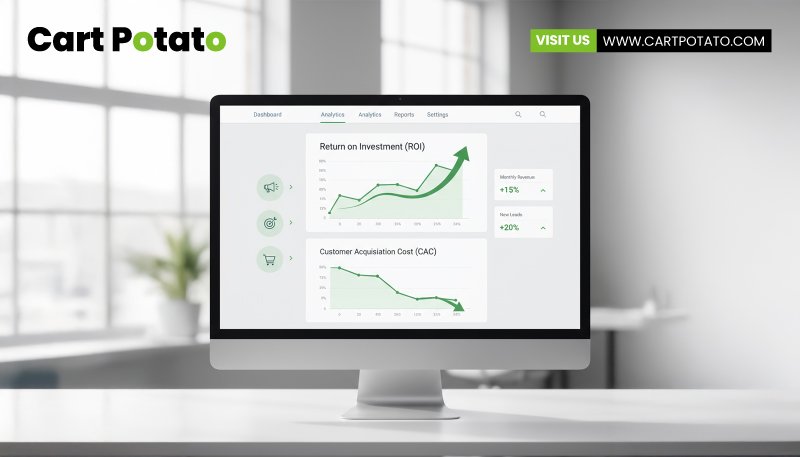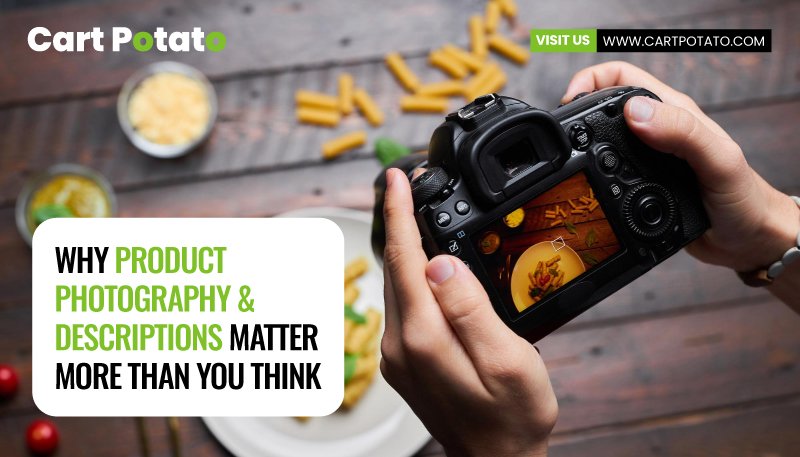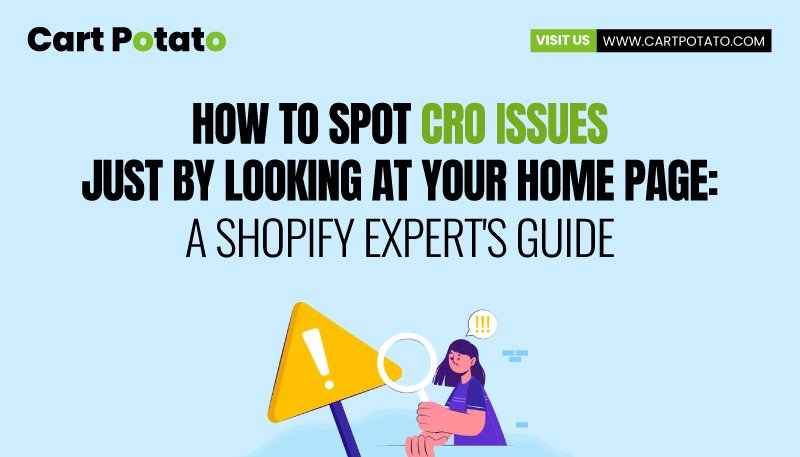
How to Kickstart Your First Ecommerce Sale – A Beginner’s Guide
Welcome to Cart Potato’s beginner’s guide on Kickstart Your First Ecommerce Sale! As a new online store owner, it’s natural to get caught up in the excitement of launching your business.
However, amidst the flurry of design decisions and pricing strategies, it’s essential not to overlook the most critical aspect of your venture: driving targeted traffic to your store.
In this comprehensive guide, we’ll walk you through the importance of targeted traffic for new stores and provide actionable strategies to help you attract your ideal customers.
From leveraging free traffic sources to exploring paid advertising and engaging with existing audiences, we’ll cover everything you need to know to kickstart your ecommerce journey successfully.
So, whether you’re just starting or looking to enhance your existing marketing efforts, buckle up and get ready to learn how to drive traffic, make sales, and grow your online store like a pro.
Why Targeted Traffic Is Essential for New Stores?
As a new online store owner, it’s tempting to get caught up in the minutiae of design details like brand colours and fonts, or endlessly tinkering with pricing. However, true progress only comes when you expose your business to the world. Without traffic, it’s impossible to gauge interest in your products, evaluate pricing strategies, or determine if your brand resonates with your target audience.
Let’s begin by exploring the readily accessible free traffic sources to get started, before delving into more focused and potentially lucrative marketing avenues.
Before You Begin: Important Considerations
Before diving into your marketing efforts, it’s crucial to establish some ground rules to ensure your strategies align with your store’s offerings and goals.
1. Relevance: If a particular tactic doesn’t align with your store’s products or target audience, it’s best to skip it. For instance, if you’re selling computer keyboards, platforms like Pinterest may not be the most suitable choice.
2. Preparation: Set up Google Analytics beforehand to track and monitor your website traffic as you implement various marketing tactics. Not every approach will yield immediate results, so be prepared to analyze and adapt quickly over the next 30 days as you strive to make your first sale.
Exploring Free Traffic Sources: Targeting Low-Hanging Fruit
To kickstart your marketing journey, begin by exploring free traffic sources that are readily accessible to all online store owners. These avenues typically involve manually sharing your store with your network and relevant online communities.
As you delve into these free traffic sources, keep the following tips in mind:
1. Incentives: Consider offering enticing incentives, such as discount codes, to encourage people to visit your store and make a purchase.
2. Leverage Online Presence: Utilize your online presence to drive traffic back to your store. Include your store URL in your personal online profiles, such as your Instagram bio or LinkedIn profile.
3. Authentic Engagement: Avoid spamming audiences with repetitive and low-quality promotional messages. Instead, focus on providing genuine value and fostering authentic connections with your audience.
By adhering to these principles, you can effectively leverage free traffic sources to attract potential customers to your online store while maintaining authenticity and integrity in your marketing efforts.
Harness Your Personal Networks
Many entrepreneurs kick start their sales journey by tapping into their personal connections, and there’s no shame in that approach. Share your store on your personal social media platforms such as Facebook, Twitter, LinkedIn, Instagram, and Snapchat to announce its launch to your entire network.
Consider reaching out directly via email to your closest connections and ask for their support in spreading the word about your store. Encourage them to share your store with their own networks, even if they don’t make a purchase themselves.
While sales from personal connections may not carry the same level of satisfaction as those from complete strangers, they provide valuable opportunities for early feedback and support.
If you don’t immediately generate sales through this method, don’t be discouraged. Keep in mind that this is often the least qualified source of traffic in your marketing arsenal.
Recommended for: Everyone, especially individuals with active online presences and large personal networks on platforms like Facebook, Instagram, Snapchat, Twitter, and LinkedIn.
Engage with Online Communities
Never underestimate the power of placing your store link strategically. Join relevant Facebook Groups, and discover niche online communities within your industry. Each of these platforms presents an opportunity to connect with individuals who share specific interests related to your business.
Join groups frequented by your target customers and actively participate to build rapport within the community. As you establish genuine connections and develop a positive reputation, you can subtly introduce your store link, perhaps accompanied by a discount code.
Moreover, these communities can serve as valuable resources for seeking assistance and guidance from seasoned entrepreneurs. Consider exploring the following communities:
– r/Entrepreneur
– r/ecommerce
– Shopify Entrepreneurs Facebook Group
– Grow and Sell Facebook Group
– Bright Ideas and Entrepreneurs LinkedIn Group
– Shopify Community
Paid Advertising: Investing in Growth
To achieve targeted traffic swiftly, investing in paid advertising is often the most effective approach. Fortunately, many paid advertising platforms operate on a pay-per-click model.
Each advertising platform offers unique features, and your choice should align with your target audience and campaign objectives. If you’re aiming for specific countries, it’s worthwhile to explore which social networks are popular in those regions.
Before delving into paid social media marketing, ensure that your main profile’s feed contains several posts. Curating content can help maintain activity on your profile, ensuring it isn’t perceived as inactive by visitors.
Utilize Facebook Advertising
Facebook stands out as one of the most popular social networks, boasting a diverse user base in terms of age, income, gender, and ethnicity, as highlighted by Pew Research.
Given its extensive reach, brands across various industries can harness Facebook’s targeting options, which encompass age, gender, job title, location, and interests, to effectively reach their ideal customers.
Of particular significance is the targeting based on interests. By leveraging the pages that users have liked on Facebook, businesses can construct detailed buyer profiles, enabling precise targeting of their ads.
Utilize Instagram Advertising
Instagram’s visual-centric platform and predominantly millennial audience make it a compelling choice for advertising.
Notably, Instagram boasts one of the most engaged user bases among social networks, according to data from Smart Insights. Beyond being a hub for influencer marketing, Instagram provides an avenue for unpaid posts to reach a substantial audience, especially when leveraging relevant hashtags.
With Instagram advertising, businesses can showcase their products through visually appealing ads displayed in users’ feeds, driving traffic to their websites.
Google Ads
When consumers embark on a purchasing journey, their first instinct is often to search for products or services on Google. Google Ads, previously known as Google AdWords, empowers businesses to elevate their visibility by appearing at the top of search results pages for relevant terms.
Google Ads provides various advertising options, including text ads prominently featured in search results, and Shopping Ads that showcase product photos and prices in an ecommerce-oriented format.
To leverage Google Ads effectively, conduct comprehensive keyword research to gauge the search volume for terms relevant to your target audience. While some may find the Google Ads interface daunting, consider enlisting the expertise of a Shopify Expert to navigate this opportunity seamlessly.
Outreach: Engaging with Existing Audiences
Simply broadcasting your brand message from your own platform might not yield the desired results. Fortunately, the internet has democratized content creation, allowing individuals to build their platforms and enabling partnerships.
These outreach tactics not only drive traffic but also leverage content to enhance your brand’s credibility. Each successful collaboration serves a dual purpose, aiding in both traffic generation and brand credibility building.
Reach out to Bloggers
It’s no secret that online publishers constantly seek fresh content and compelling stories.
By crafting a solid pitch centered around an intriguing story or product, you can secure a spot on a blog or publication frequented by your target audience. Identify publications aligned with your niche and pitch them about your brand.
Consider the following partnership ideas:
Write and submit a guest post. Share your expertise on a topic relevant to your niche, leveraging your author bio to describe and link to your business.
Request product reviews. Provide your product to a blogger for review in exchange for exposure.
Pitch a news story. Utilize your brand’s compelling origin story or unique product as the focal point for an interview-style piece.
Ensure your pitch resonates with both the writer or editor and their audience. Prioritize publications that align with your brand’s values and audience demographics.
Partner with Influencers
Influencer marketing isn’t solely reserved for big brands. Collaborating with influencers—content creators with sizable followings in your niche—offers access to an established fanbase and the creation of promotional content.
Influencers span various platforms, from YouTube to Instagram. While you can directly negotiate deals with them, several influencer marketplaces facilitate connections between creators and brands.
Analyze: Reflecting Back to Optimize
By now, you’ve likely experimented with various tactics, resulting in an increase in traffic and perhaps even some sales. This challenge aims to create a feedback loop where you expose your store to traffic, establish performance benchmarks, and then work on improvements.
Now, it’s time to analyze potential issues with your store by examining your analytics dashboard (both in Shopify and Google Analytics), along with the feedback received from actively promoting your store.
Several factors could contribute to customers not making purchases, and you can make informed assessments based on your traffic behavior:
High bounce rates, indicating visitors leaving your site immediately, could stem from low-quality traffic or slow loading times (you can test the latter here).
Lack of product additions to the cart might signify a mismatch between your product and the market, or a lack of trust in your store.
Numerous abandoned carts during checkout could indicate issues with your shipping policies.
Armed with these insights, you can start refining aspects of your store to enhance your chances of success with future marketing endeavors.
Expanding your reach requires actively engaging with your target audience in a landscape filled with endless opportunities. This is what makes marketing both exciting and daunting—there’s a plethora of avenues to explore.
There’s no universal formula for success in this realm. It’s about experimenting, experiencing setbacks, learning from them, and refining your approach. So, don’t hesitate to put your store out there, as it’s the fundamental step towards growth. And if you find yourself facing challenges, our guide on diagnosing and enhancing your store’s performance when driving traffic but not seeing sales can offer valuable insights.
Conclusion:
Remember, building a successful ecommerce business takes time, patience, and continuous effort. By prioritizing targeted traffic, experimenting with various marketing tactics, and analyzing your results, you’ll be well-equipped to drive sales and achieve your business goals.
At Cart Potato, we’re committed to helping ecommerce entrepreneurs like you succeed. Whether you’re looking for expert guidance on Shopify and Shopify Plus or need assistance with your digital marketing efforts, we’re here to support you every step of the way.








